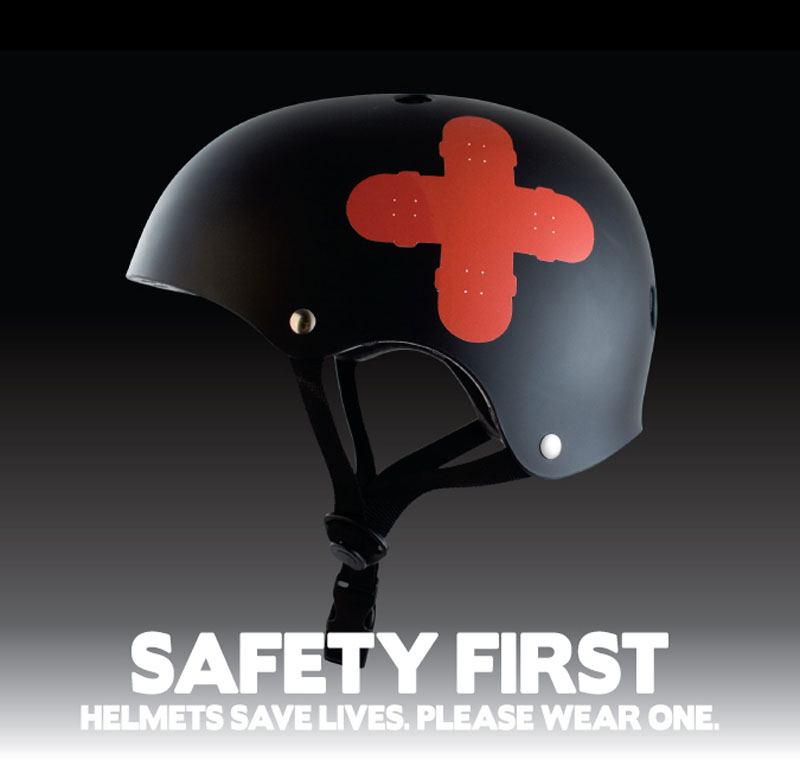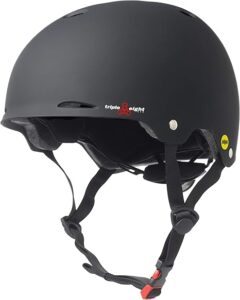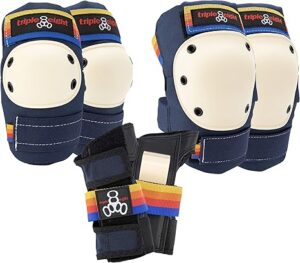
Skateboarding is an increasingly popular recreational activity among teenagers–especially young men and women.
Practice skateboarding safely and use protective equipment. It is a fun and healthy sport that can give you a low-impact aerobic workout. Skateboarding is very rewarding when done safely.
Incidence of Injury
To improve skateboarding safety, a growing number of communities provide supervised skateboard parks. These may have professionally designed “bowls” and “ramps” or other designated skateboarding areas that are located away from motor vehicle and pedestrian traffic.
Skateboarding is an activity in which you move quickly over hard surfaces. It can lead to injuries that range from minor cuts and bruises to catastrophic brain injury. Each year in the United States, skateboarding injuries cause about 50,000 visits to emergency departments and 1500 children and adolescents to be hospitalized. (Source: AAP, March 2002. ) Read more about skateboard injury statistics to help you find the right safety gear.
Most hospitalizations involve head injury. Even injuries that heal quickly can cause pain and anxiety, cost time, and money and may lead to disabilities. This can include loss of vision, hearing and speech; inability to walk, bathe, toilet, dress or feed yourself; and changes in thinking and behavior.
Skateboarding is not recommended for young children. That’s because they are still growing and do not yet have the physical skills and thinking ability a person needs to control a skateboard and ride it safely.
According to the American Academy of Pediatrics (AAP):
- Children under age 5 years old should never ride a skateboard.
- Children aged 6 to 10 years old need close supervision from an adult or trustworthy adolescent whenever they ride a skateboard.
- When young children are involved in skateboarding accidents, they are often injured severely. Skateboarding is a special risk for young children because they have:
- A higher center of gravity, less development and poor balance. These factors make children more likely to fall and hurt their heads.
- Slower reactions and less coordination than adults. Children are less able to break their falls.
- Less skill and ability than they think. Children overestimate their skills and abilities and are inexperienced in judging speed, traffic and other risks.
Serious skateboarding injuries happen when you lose control and fall or run into a motor vehicle, road hazard, pedestrian, another skateboarder or bicyclist. You are at risk for injuries:
- If you don’t use protective equipment.
- If you don’t keep your skateboard in good condition.
- If you skateboard on irregular surfaces.
- If you attempt “tricks” beyond your skill level.
Sixty percent of skateboard injuries involve children under age 15; most of those injured are boys. At highest risk are:
Inexperienced skateboarders. Those who have been skating for less than one week suffer one-third of injuries, usually caused by falls.
Skateboarders who do not wear protective equipment. Every skateboarder should wear standard safety gear. This includes a helmet, wrist guards, elbow and knee pads and appropriate shoes. Skateboarders who perform tricks should use heavy duty gear.
Skateboarders who go near traffic or use homemade skateboard ramps. Both activities are particularly dangerous.
Experienced skateboarders who encounter unexpected surfaces or try risky stunts. Irregular riding surfaces, rocks or other debris can cause you to fall. You can stumble over twigs or fall down slopes. Wet pavements and rough or uneven surfaces can cause a wipeout. Avoid risky behavior. Don’t skateboard too fast or in dangerous or crowded locations.
Types of Injury
Skateboarding injuries often involve the wrist, ankle or face. Many injuries happen when you lose your balance, fall off the skateboard and land on an outstretched arm.
- Injuries to the arms, legs, neck and trunk range from bruises and abrasions to sprains and strains, fractures and dislocations. Wrist fractures are quite common. Wearing wrist guards can reduce their frequency and severity.
- Facial injuries include breaking your nose and jawbone
- Severe injuries include concussion, closed head injury and blunt head trauma.
- You can suffer permanent impairment or even death if you fall off the skateboard and strike your head without a helmet. Most brain injuries happen when your head hits pavement.
You are most at risk if you skateboard near traffic and collide with motor vehicles, bikes, pedestrians or other obstacles.
Skateboard Injury Prevention
You can prevent most skateboarding injuries if you follow all of these recommendations:
Use a quality skateboard
Skateboards have three parts-the deck (the board itself), the trucks (the mechanism to which wheels are attached) and the wheels. Shorter decks are best for beginners because they are easier to balance and handle. Skateboards have various characteristics for all types of riding including slalom & downhill, freestyle, and speed. Some are rated for the user’s weight.
We found this guide to finding the best longboard for beginners really useful.
Keep your skateboard in proper working order
You should inspect it before every ride. Look for problems that need repair. These can include loose, broken or cracked parts; sharp or jagged edges; a slippery top surface; wheels with nicks and cracks, etc.
It’s a good idea to get professional help to repair serious defects.
Learn the basic skills of skateboarding, especially how to stop properly
Learning how to stop takes some practice, that is for sure. In addition to stopping, learn slowing and turning techniques, and how to fall safely: If you are losing your balance, crouch down on the skateboard so you won’t have as far to fall. Try to land on the fleshy parts of your body rather than your arms. Relax and roll.
Wear proper protective equipment
Before getting on your skateboard, empty your pockets of all hard and sharp objects and put on your protective gear. Essential protective equipment includes:
- A properly fitting helmet
- Wrist guards
- Knee and elbow pads
- Shoes
Wear a Helmet
To protect your head from injury, always wear a properly fitting helmet. This is true no matter what your age, level of experience or location where you are skateboarding. Get a quality bicycle or multi-sport helmet. It should meet or exceed safety standards of the U.S Consumer Product Safety Commission (CPSC) or Snell Memorial Foundation. You may need to try on several sizes and models to find a helmet that fits your head correctly and securely. A properly fitting helmet:
- Is worn flat on your head with the bottom edge parallel to the ground
- Sits low on your forehead
- Has side straps that form a “V” shape around each ear
- Has a buckle that fastens tightly (there should be room to put only two fingers between the strap and your chin)
- Has pads inside that you install or remove so the helmet fits snuggly
- Does not move in any direction when you shake your head
- Does not interfere with your movement, vision or hearing
Replace your helmet when it is damaged, outgrown or at least every five years. You may need to replace it sooner if the manufacturer recommends it.
Note: Effective January 1, 2003, California has expanded its bicycle helmet law to require that children under age 18 wear helmets each time they use a skateboard, inline skates, roller skates or scooter, making the state’s child helmet law the strictest in the nation. Violators face fines of $25, most of which benefits local health departments promoting helmet safety education and subsidizing helmet purchases for low-income families. Learn more about skateboard laws and regulations.
Popular & Safe Helmets Worn by Skateboarders
You will find a wide variety of helmets. We recommend looking at helmets that are certified for safety and that fit you properly. Many skateboard helmets are multi-sport, so don’t worry if you find a helmet that you like that says it is a bike helmet!
One challenge that most parents have while buying helmets is finding one that their children don’t mind wearing. Even though you think being safe is cool enough, they may disagree. Here are options that parents have told us are “cool enough”, according to their kids.

Wear Wrist Guards, Knee Pads and Elbow Pads
Wrist guards help support the wrist and reduce the chances of breaking a bone if you fall. Knee and elbow pads reduce the severity of cuts and scrapes, and prevent gravel burns. You should also wear closed, slip-resistant shoes, and consider goggles to keep debris out of your eyes.
Skateboard only on smooth pavement away from traffic, preferably in a supervised skate park.
- Never hold onto the side or rear of a moving vehicle while riding a skateboard (“skitching”). You could fall or be thrown into oncoming traffic if the vehicle suddenly slows, stops or turns.
- Never use your skateboard in wet weather.
- Avoid skateboarding in crowded walkways or in darkness.
- Always screen the area before you skateboard, inspecting surfaces for rocks and other debris.
- Be careful with tricks and jumps.
Skateboarding skill is not acquired quickly or easily. Don’t take chances by skateboarding faster than your experience allows, or faster than is safe for conditions or the speed of other skateboarders. If you try tricks and jumps, practice them only in a controlled environment, such as a skate park that has adult supervision and appropriate access to emergency medical care.
Popular & Safe Wrist Guards, Knee Pads, & Shin Pads
Now you know it’s a good idea for new and inexperienced skateboarders to wear pads. Check out some beginner skateboard safety equipment available and find the protection you need based on the guidelines we’ve laid out.

Stay in shape.
Prevent skateboarding injuries by keeping in top physical condition.
- Stretch and do conditioning exercises before and after skateboarding.
- Do not use headphones while skateboarding.
- Never put more than one person on a skateboard.
- Be considerate of fellow skateboarders, especially those who are younger and / or less skilled.
- Know what to do in an emergency.
Emergency Situations
Skateboarding accidents happen, so you should always know what to do in emergency situations. Don’t panic. Call 911 for medical assistance or an ambulance.
The best reaction you can have if a fellow skateboarder has a serious injury is to make sure that one person dials 911. If you are the first to arrive at your friend’s side after a fall, point to someone standing around you, make eye contact, and say “You! You call 911.” This will make sure that someone gets in touch with emergency services as soon as possible so that your friend can get treatment for their injury.
If you are the fallen skateboarder and take a nasty spill, stay calm. There is nothing wrong with taking a few moments to assess whether or not you have any injuries. When you take a fall or hit your head, your body may react by spiking your adrenaline or going into shock–that means you may not be thinking clearly. If you can, relax and wait for another skateboarder to come assist you.